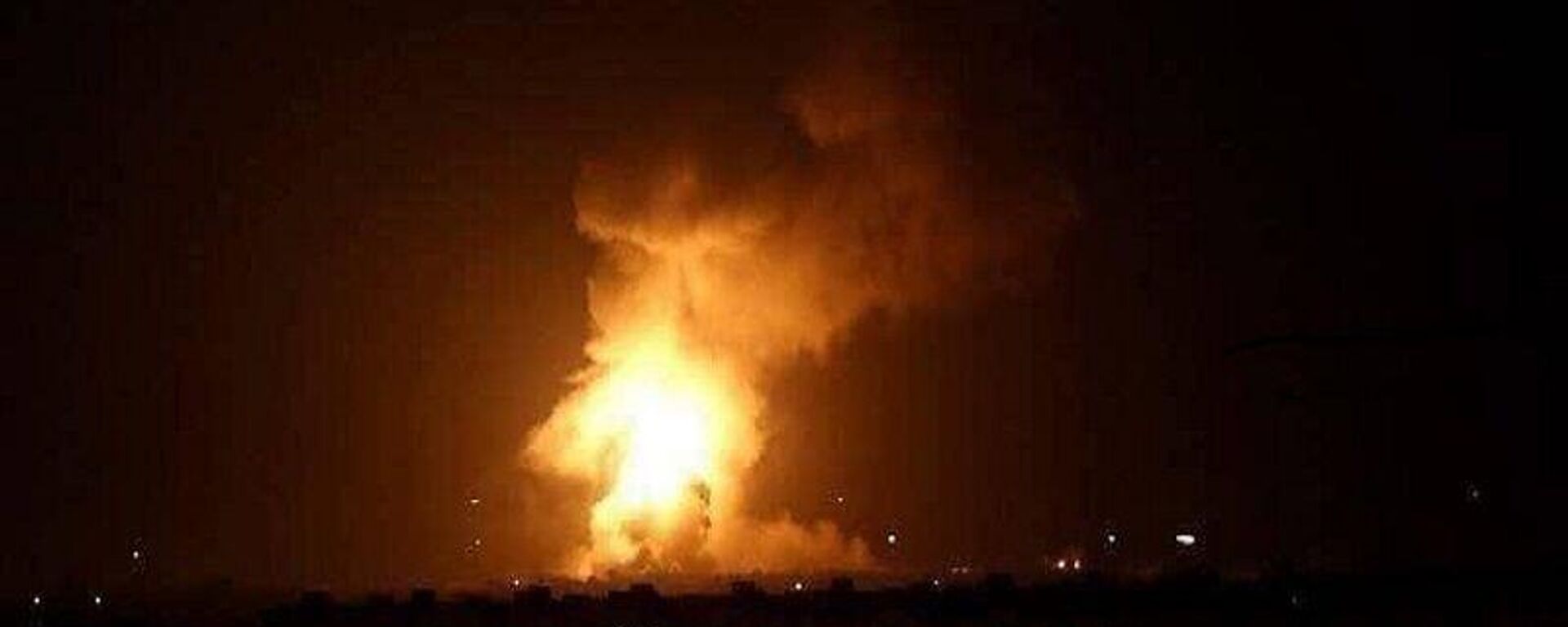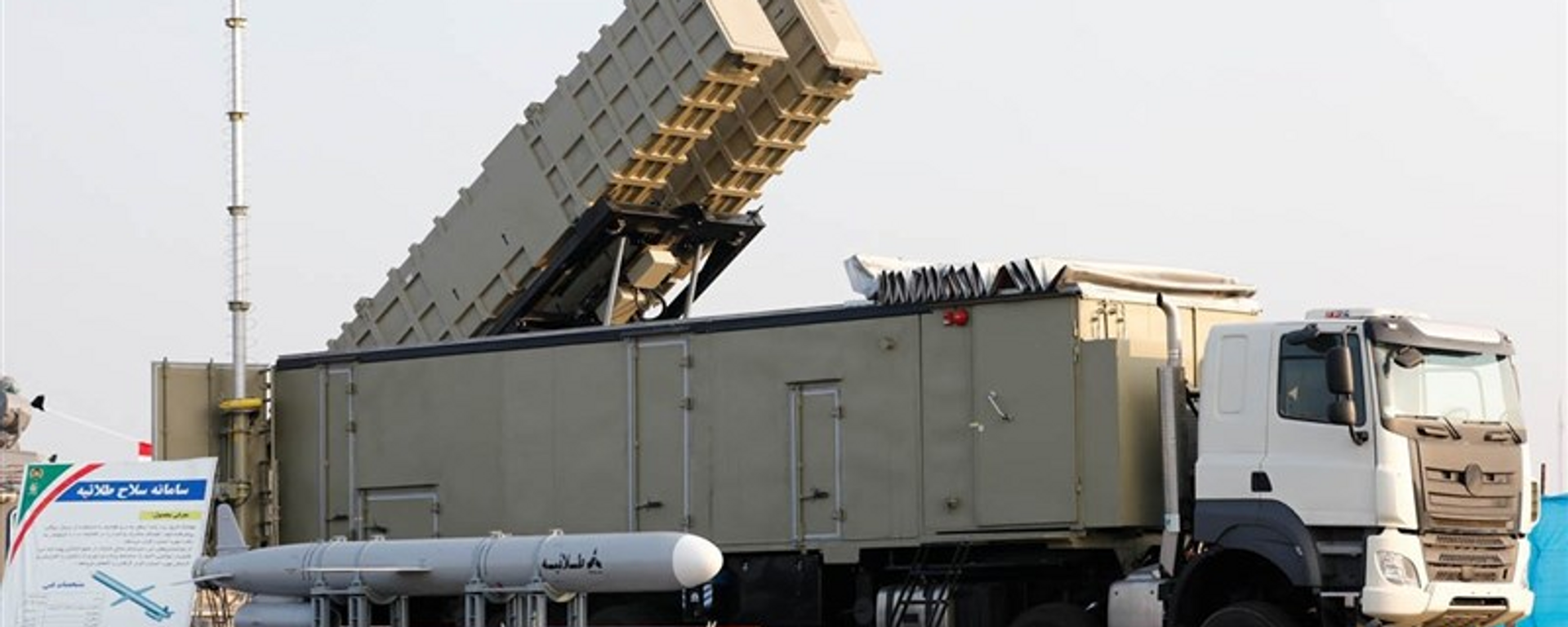https://sputnikglobe.com/20240116/going-ballistic-what-are-irans-medium-range-missile-capabilities-1116206189.html
Going Ballistic: What are Iran’s Medium-Range Missile Capabilities?
Going Ballistic: What are Iran’s Medium-Range Missile Capabilities?
Sputnik International
IRGC Uses ‘Fortress Buster’ to Trounce Terrorists: What Other Ballistic Missiles Does Iran Possess?
2024-01-16T18:35+0000
2024-01-16T18:35+0000
2024-01-30T10:33+0000
military
qasem soleimani
hossein salami
middle east
syria
iraq
khuzestan
islamic revolutionary guard corps (irgc)
mossad
fajr
https://cdn1.img.sputnikglobe.com/img/07e8/01/10/1116206021_0:141:3140:1907_1920x0_80_0_0_42fef3d2c67a70a062c023f5c558a15e.jpg
Iran deployed its new Kheibar-Shekan (lit. ‘Castle Buster’ or ‘Fortress Buster’) medium-range ballistic missile during Monday night’s strikes against terror targets in Syria, Islamic Revolutionary Guard Corps Aerospace Force Commander Amir Ali Hajizadeh has revealed.A total of four Kheibar-Shekan missiles were fired from Khuzestan province in southwestern Iran, Hajizadeh indicated during talks with IRGC Chief Hossein Salami on Tuesday.That means the missiles traveled at least 1,230 km to reach jihadist-controlled Idlib province in Syria.First unveiled in 2022, the Kheibar-Shekan is a 4.5 ton, 10.5 meter long ballistic missile with a 1,450 km range – enough to strike any point in Israel – Iran’s main regional rival, as well as most US military bases across the Middle East. The missile has a 500-kilogram conventional high-explosive warhead.The missile’s engine is solid fueled, which means dramatically reduced preparation for launch times and fewer maintenance requirements compared to liquid-fueled rocket engines. It’s also equipped with maneuverable reentry vehicle (MaRV) capability, which means reduced effectiveness for any enemy missile defenses seeking to shoot it down during flight.The missiles’ were used in Syria on Monday night to target facilities used by terrorists as part of the IRGC’s response to deadly terror attacks against the Iranian cities of Rask and Kerman in mid-December and early January. Sources told Lebanon’s Al-Mayadeen news channel that the missile attack targeted “training camps, logistical support headquarters, and a medical point for militants of the Turkestan Islamic Party*, an al-Qaeda*-linked terror group” reportedly engaged in the training of IS* offshoot ISIS-Khorasan* to conduct terror attacks inside Iran.Iran's Other Medium-Range MissilesThe Kheibar-Shekan is among the newest and most advanced ballistic missiles in Iran’s arsenal, but certainly not the only one. Missiles comparable to the Kheibar-Shekan include:Shorter Range Missiles in Iran’s ArsenalFor engagements nearer to home, including against ground targets and sea-based enemies in the Persian Gulf and the Indian Ocean, Iran has shorter-range missiles, as well as cruise missiles.Advanced cruise missile capabilities include the recently-introduced Abu Mahdi – a 1,650 kg, 6 meter long anti-ship cruise missile with a 3.1 meter wingspan and a 410 kg warhead. The missile has a range of over 1,000 km and radar-evasion capabilities, and is named after Abu Mahdi al-Muhandis, the Iraqi militia leader killed alongside IRGC Quds Force Commander Qasem Soleimani in January 2020 in an unprovoked US assassination attack.Incidentally, Iran responded to the al-Muhandis and Soleimani killings by firing Fatah-313 and Qiam 1 ballistic missiles at two US bases in Iraq. The former is a solid-fuel missile with a 380 kg warhead and a 500 km range. The latter is a liquid-fueled missile with a 750 kg warhead and an 800 km range, and a development of the Soviet-era Scud-C missile. Iran warned its Iraqi partners ahead of the strikes, giving US troops enough time to take cover. Nevertheless, 110 US military personnel suffered traumatic brain injuries (mainly concussions) in the attack, with nearly 70 of them later awarded Purple Hearts.* Terrorist groups outlawed in Russia and many other countries.
https://sputnikglobe.com/20231119/iran-reveals-fattah-2-hypersonic-missile-media-1115060185.html
https://sputnikglobe.com/20240116/irans-strike-on-erbil-calculated-demonstration-of-missile-abilities--1116191139.html
https://sputnikglobe.com/20231224/irans-navy-gets-new-cruise-missiles-advanced-choppers-as-regional-tensions-surge-1115782820.html
syria
iraq
khuzestan
Sputnik International
feedback@sputniknews.com
+74956456601
MIA „Rossiya Segodnya“
2024
News
en_EN
Sputnik International
feedback@sputniknews.com
+74956456601
MIA „Rossiya Segodnya“
Sputnik International
feedback@sputniknews.com
+74956456601
MIA „Rossiya Segodnya“
iranian ballistic missiles, iranian strikes on syria, iranian strikes on iraq, iranian strikes on northern iraq, iranian strikes on erbil, what ballistic missiles does iran have, iran medium-range ballistic missiles, iran short-range ballistic missiles
iranian ballistic missiles, iranian strikes on syria, iranian strikes on iraq, iranian strikes on northern iraq, iranian strikes on erbil, what ballistic missiles does iran have, iran medium-range ballistic missiles, iran short-range ballistic missiles
Going Ballistic: What are Iran’s Medium-Range Missile Capabilities?
18:35 GMT 16.01.2024 (Updated: 10:33 GMT 30.01.2024) Committing never to build nuclear weapons or other WMDs on religious grounds, Iran has come to rely on its ballistic and cruise missile arsenal as its main means of strategic defense. The US and its allies have repeatedly tried to rein in the Islamic Republic’s missile developments by treaty, but to no avail.
Iran deployed its new Kheibar-Shekan (lit. ‘Castle Buster’ or ‘Fortress Buster’) medium-range ballistic missile during Monday night’s strikes against terror targets in Syria, Islamic Revolutionary Guard Corps Aerospace Force Commander Amir Ali Hajizadeh has revealed.
A total of four Kheibar-Shekan missiles were fired from Khuzestan province in southwestern Iran, Hajizadeh indicated during talks with IRGC Chief Hossein Salami on Tuesday.
That means the missiles traveled at least 1,230 km to reach jihadist-controlled Idlib province in Syria.
First unveiled in 2022, the Kheibar-Shekan is a 4.5 ton, 10.5 meter long ballistic missile with a
1,450 km range – enough to strike any point in Israel – Iran’s main regional rival, as well as most US military bases across the Middle East. The missile has a
500-kilogram conventional high-explosive warhead.
The missile’s engine is solid fueled, which means dramatically reduced preparation for launch times and fewer maintenance requirements compared to liquid-fueled rocket engines. It’s also equipped with maneuverable reentry vehicle (MaRV) capability, which means reduced effectiveness for any enemy missile defenses seeking to shoot it down during flight.
The Kheibar-Shekan is a not-so-subtle reference to the Battle of Kheibar between followers of the Prophet Muhammad and Jewish tribesmen who barricaded themselves in a series of forts at an oasis in the northwestern Arabian Peninsula in the year 628 CE.
The missiles’ were used in Syria on Monday night to target facilities used by terrorists as part of the IRGC’s response to deadly terror attacks against the Iranian cities of Rask and Kerman in mid-December and early January. Sources
told Lebanon’s Al-Mayadeen news channel that the missile attack targeted “training camps, logistical support headquarters, and a medical point for militants of the Turkestan Islamic Party*, an al-Qaeda*-linked terror group” reportedly engaged in the training of IS* offshoot ISIS-Khorasan* to conduct terror attacks inside Iran.
Iran's Other Medium-Range Missiles
The Kheibar-Shekan is among the newest and most advanced ballistic missiles in Iran’s arsenal, but certainly not the only one. Missiles comparable to the Kheibar-Shekan include:
The
Ashura –a solid-fueled two-stage strategic medium-range ballistic missile with a 2,000-2,500 km operational range developed in the late 2000s, but without MaRV capability onboard.
The
Fajr-3, a medium-range radar-evading, multiple independently targetable reentry vehicle (MIRV)-equipped ballistic missile with a range of up to 2,000 km. This missile is liquid-fueled, meaning a longer preparation time and higher maintenance requirements.
The
Fattah 1, Iran’s new hypersonic, maneuvering medium-range missile with a 350-450 kg payload and a 1,400 km range (Iran
plans to extend the range by up to 600 km). First unveiled in the summer of 2023.

19 November 2023, 18:53 GMT
The
Ghadr-110 – a first stage liquid, second stage solid-fueled missile with an 1,800-2,000 km range developed and introduced in the mid-2010s. A development of the Shahab-3 missile (more info below).
The
Kheibar (Khorramshahr-4) – a medium-range ballistic missile introduced in 2023 with a massive 1,500 kg warhead (enough to destroy deep fortifications and heavy entrenchments) and a 2,000 km range. The missile is powered by a liquid-fueled engine. Constitutes the latest development of the Khorramshahr family of medium-range ballistic missiles.
The
Shahab-3 ER, another liquid-fueled medium-range missile with a 1,000-2,000 km range developed in the 2000s which can be fitted with a 1,200 kg warhead, or up to five separate 280 kg warheads in a MIRV arrangement. Another derivative of the Shahab-3 series is the Emad, which was unveiled in 2015 and features a 750 kg warhead. Can be fired at targets up to 1,700 km away.
The
Sejjil – a solid-fuel inertial-GPS-guided medium-range ballistic missile with a range of at least 2,500 km (and by some accounts up to 4,500 km) and a 500-1,500 kg warhead.
Shorter Range Missiles in Iran’s Arsenal
For engagements nearer to home, including against ground targets and sea-based enemies in the Persian Gulf and the Indian Ocean, Iran has shorter-range missiles, as well as cruise missiles.
These include the Fateh-110 – a solid fuel rocket with a 300 km range and a 500 kg warhead which it has used extensively against a Mossad intel-gathering center in Erbil, Iraq in March 2022, and reportedly used again in the IRGC attack this week – again targeting a “spy headquarters” belonging to the Israeli intelligence agency.

16 January 2024, 09:31 GMT
Advanced cruise missile capabilities include the recently-introduced Abu Mahdi – a 1,650 kg, 6 meter long anti-ship cruise missile with a 3.1 meter wingspan and a 410 kg warhead. The missile has a range of over 1,000 km and radar-evasion capabilities, and is named after Abu Mahdi al-Muhandis, the Iraqi militia leader killed alongside IRGC Quds Force Commander Qasem Soleimani in January 2020 in an unprovoked US assassination attack.
Incidentally, Iran responded to the al-Muhandis and Soleimani killings by firing Fatah-313 and Qiam 1 ballistic missiles at two US bases in Iraq. The former is a solid-fuel missile with a 380 kg warhead and a 500 km range. The latter is a liquid-fueled missile with a 750 kg warhead and an 800 km range, and a development of the Soviet-era Scud-C missile. Iran warned its Iraqi partners ahead of the strikes, giving US troops enough time to take cover. Nevertheless, 110 US military personnel suffered traumatic brain injuries (mainly concussions) in the attack, with nearly 70 of them later awarded Purple Hearts.

24 December 2023, 11:23 GMT
* Terrorist groups outlawed in Russia and many other countries.





